CHICAGO – Patrick McDonald of HollywoodChicago.com appears on “The Morning Mess” with Dan Baker on WBGR-FM (Monroe, Wisconsin) on March 21st, 2024, reviewing the new streaming series “Manhunt” – based on the bestseller by James L. Swanson – currently streaming on Apple TV+.
Interview: French Filmmaker Gaspar Noé Dares to ‘Enter the Void’
CHICAGO – Few films have conveyed the sensation of an out-of-body experience quite like “Enter the Void,” the latest feature from French filmmaker Gaspar Noé, who continues to be one of the most controversial and innovative filmmakers in modern cinema. When his characters get high, their souls float through space, an experience skillfully depicted by Noé, despite the fact that he’s never experienced it himself.
“I’ve tried for many years to have an out-of-body experience and I’ve never managed to have any,” Noé admits.
The son of an Argentine painter, Noé first gained notoriety with his 1991 short, “Carne,” which was later followed by two features that garnered equal amounts of acclaim and outrage at international festivals. “I Stand Alone” (1998) and “Irreversible” (2002) confronted deeply disturbing subject matter with an almost animalistic intensity, while allowing audiences to reflect on the repercussions of their epically intimate tragedies. Noé’s nihilistic worldview is apparent throughout his work, but his craft is bristling with life and vitality. “Void” is the film that he’s been working toward his entire career, and was a project he had been planning for quite some time.
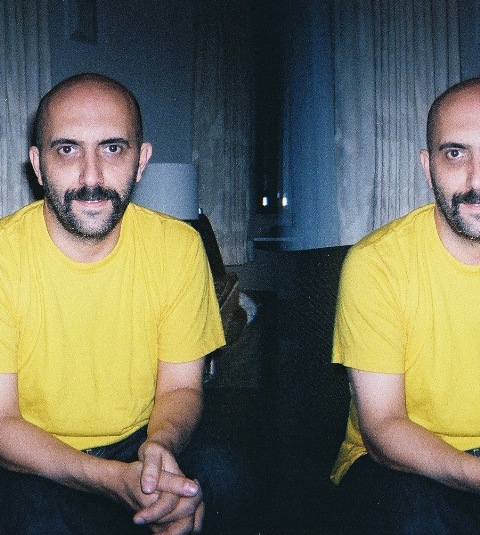
Gaspar Noe
Photo credit: IFC Films
“I had written a draft of ‘Enter the Void’ three years before I shot ‘Irreversible,’” Noé says. “I was getting into a production with a German company and a French company, and a few months before the summer of 2001, the whole thing began falling into pieces. So I had this idea of doing another small erotic movie. When I met Vincent Cassel and Monica Bellucci, they said they would be interested in doing that, but it might be too erotic. Finally we changed that project into ‘Irreversible,’ and we shot the film with almost no script. We only had three pages when we started shooting the movie. When I started shooting, I used many cinematic games that I had in mind for ‘Enter the Void.’ That’s why all the scenes in ‘Irreversible’ are long master shots and that’s also why I had crane shots flying above the city at the beginning. I thankfully did that movie before [‘Void’] because I found out how complex it was to work with cranes and how difficult it also was to work with CGI.”
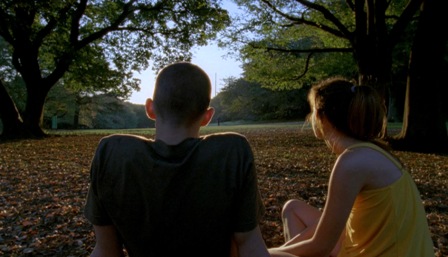 Enter the Void Photo credit: IFC Films |
Though “Void” is first and foremost a visual experience, it does contain a plot, centering on a young drug dealer, Oscar (Nathaniel Brown), who’s visited by his adoring sister, Linda (Paz de la Huerta), while in Tokyo. After being gunned down by police, Oscar’s disembodied spirit struggles to stay connected with his sister, who works as a stripper. Loosely following the structure of “The Tibetan Book of the Dead,” the film take viewers on a psychedelic journey through Oscar’s afterlife, as he witnesses moments from his troubled upbringing, where he became inextricably devoted to his sister at a young age, after their parents’ sudden death. As in “Irreversible,” Noé demonstrates that life can change in a heartbeat simply by going down the wrong tunnel.
In “Void,” Noé continues the tradition of connecting his new work with elements from his previous films, creating somewhat of a cinematic umbilical cord between projects. Just as Philippe Nahon, the star of “Carne” and “I Stand Alone,” appeared at the beginning of “Irreversible,” Noe has found subtle ways of referencing “Irreversible” in the opening moments of “Void.”
“I referenced ‘2001: A Space Odyssey’ with the poster on [Monica’s] wall at the end of ‘Irreversible’ because in the original draft of ‘Enter the Void,’ the kids were talking about ‘2001: A Space Odyssey’ all the time, and they were seen watching the film,” Noé says. “It was a [method] of linking that I took from Kubrick’s films. Some directors like linking the end of their previous movie to the beginning of their next movie. I put the same soundtrack [from the end of ‘Irreversible’] at the beginning of ‘Enter the Void,’ so if you [watch] the films in a row, you have that same [shuttering sound]. It’s a private joke. [laughs] I almost thought I would put a big [‘2001’] poster in front of Oscar and Linda’s apartment in Japan. It would have been another way of linking the movie to the previous one.”
For the vast majority of the picture, Oscar is literally floating through space, occasionally soaring helplessly over the skyline of Tokyo. These sequences presented major technical challenges to Noé, who forged a unique collaboration with cinematographer Benoit Debie and key grip Akira Kanno.
“I operated the crane but the grip was pushing the car [holding] the crane,” Noé says. “I was dreaming almost every night of how I would put the crane on the set the following day. That was my main obsession on the set. My cinematographer was taking care of the lighting. It was really difficult to shoot those scenes, so he was not doing the camerawork, at least not on this movie. I’m happy that we could share all this work, and thankfully I had the best grip I could dream of. We had to rebuild all the real locations that we shot during the flashbacks. We had to rebuild them in the studio in order to be able to have actual visions from above.”
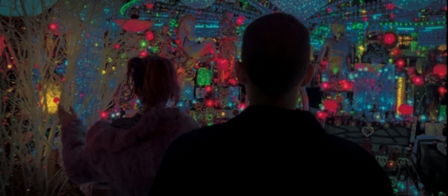 Enter the Void Photo credit: IFC Films |
Noé claims that he originally got the idea for “Void” after a memorable experience at age 23, when he watched Robert Montgomery’s first-person mystery “Lady in the Lake” while on mushrooms. This inspired Noé to make a film that literally viewed the world through the eyes of its main character. For the first section of “Void,” the audience is literally experiencing the world through Oscar’s eyes, as he walks, blinks, sleeps and hallucinates in what appears to be real time. The filming of these sequences was especially elaborate, as cast and crew members (including Noé himself) took turns “playing” Oscar’s hands, which are seen interacting with the environment.
“When Oscar is washing his face in front of the mirror, the hands you see are [those of] the camera assistant,” Noé says. “The hands were changing all the time. I [actually] told [Brown] not to put his hands in front of his eyes, and among all the eighteen takes that we had of that shot, there was one [in which] he forgot. There was actually no mirror. It was a reverse set, with the camera on one side and the actor on the other side of the hole in the wall. In one of the takes, I think it was number 15, he forgot to [avoid] putting his hands in front of his face. I said, ‘Oh, that would be great if we could keep that take and [separately film] the hands on a green background. We can [superimpose] and synchronize them with the movements of Oscar’s hands. That’s the way we did it in the end, and it looks much better than any other take.”
Despite the film’s technical challenges, Noé allowed improvisation to occur during the shoot, which occasionally resulted in moments that were visually intriguing but didn’t fit the context of a given scene (the filmmaker promises that some outtakes will be available on the film’s eventual DVD release). Noé says that there’s a particular reason why this production allowed him to reconnect with the energy he had back in the early days of his career.
“I think that was mainly because of the energy that the Japanese crew gave me,” Noé says. “When I was in film school, I could work for 12 or 14 hours a day, even when I did my first feature [‘Carne’]. There was no money but there was lots of energy. But when you work in Japan, you don’t have guilds that are as strict as in America or in France. So you end up working 6 days a week, 14 hours a day and you feel like everybody is a perfectionist trying to do his best. That’s why at that point you’re enjoying it because you feel like everybody wants to create a piece of art.”
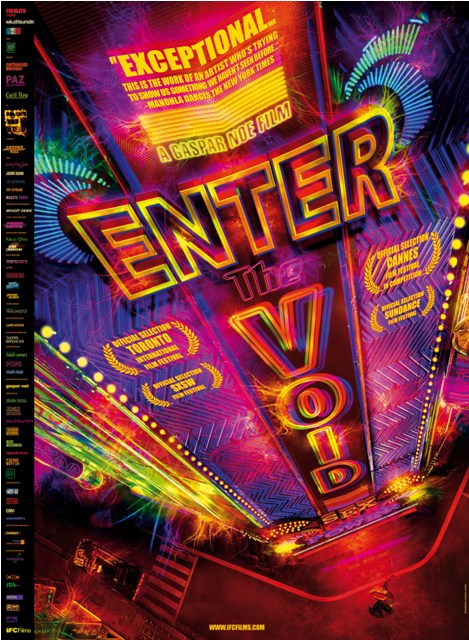
Enter the Void
Photo credit: IFC Films
Noé also worked closely with his producer/visual effects art director Pierre Buffin during the film’s extensive post-production. A true cinema junkie, Noé drew inspiration for his imagery from a variety of films that he has long admired, from Kenneth Anger’s “Inauguration of the Pleasure Dome” to the famous long takes in “I Am Cuba” and various Brian De Palma films. He says that the opening scenes in “Strange Days” rank among the best recreations of human perception in film history.
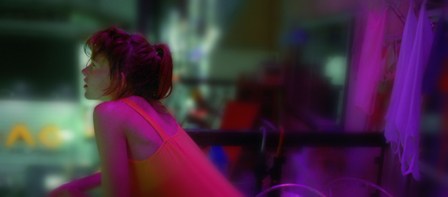 Enter the Void Photo credit: IFC Films |
“Pierre Buffin is not a drug consumer,” Noé quips. “He was not doing drugs, and all the visual effects had to be very, very trippy. I had to bring him as many references as I could. Of course Buffin has done some of the most amazing visual effects lately in Hollywood movies like ‘The Matrix’ or ‘2046.’ I brought as many references as I could: photos, videos, experimental movies, and then we would discuss around them…It was absolutely great to work with him and his team.”
As in “Irreversible,” Noé opens “Void” with an electrifying credit sequence that allows audience members to feel as if they are hallucinating before the film has officially begun. Noé says that there are a handful of directors, such as Tarantino or Godard, who have fun with their credit sequences, and he finds great enjoyment in making them memorable. Yet the filmmaker insists that there’s a simple reason behind the frenzied titles that open “Void.”
“Some people complained that the movie was long,” Noé says. “It was shown in an unfinished version at Cannes in May 2009. It was a work in progress, and had no credits either at the beginning or at the end. I said, ‘If we have to put credits in the movie, let’s make them as fast as possible and as graphic as possible.’”
Yet the running time will likely not be the only subject of controversy in “Void” when it debuts in American theaters, since the film has already garnered charges of misogyny and homophobia by some of Noé’s detractors. These criticisms were also launched at “Irreversible,” primarily because of its notorious rape sequence and arguably unfavorable depiction of gay characters. Yet the filmmaker has consistently denied such claims, and is already prepared to ignore them this time around.
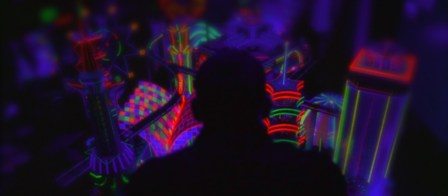 Enter the Void Photo credit: IFC Films |
“They can say whatever they want,” Noé says. “I’m not homophobic. Anybody who knows me knows that I’m not. I’d rather have the [critics] say that I’m anti-religious or something like that. I don’t care when people attack me for things that are not true. Those sorts of reviews say much more about the people writing them than about the movie itself.”
Noé’s disbelief in life everlasting mirrors his skepticism concerning the supposed immortality of cinema. The filmmaker says that the art of motion pictures will not outlast the art of the written word.
“There was an article where [Italian filmmaker Pier Paolo] Pasolini said that books stay younger than movies,” Noé says. “It’s true that if you see a movie from the ’30s, it’s in black and white. If it’s a movie from before the ’30s, it’s a silent movie. If it’s a movie from the ’50s, it still looks like the ’50s. When you read books, whether they come from one century or two centuries ago, they always seem modern because the way they’re printed has not changed. The way words are used hasn’t changed as much as film technique. So no matter what [filmmakers] are doing now, it will be out of fashion very soon. Even the movie that is, for me, the most futuristic movie ever, ‘2001,’ has some details that now seem very old fashioned.”
When asked whether the rapidly aging art form inspires him to create more audacious and lasting work, Noé responds, “You have to have fun. You’re not going to stay here long, so as long as you’re here, you have to have fun. That’s the thing, if you can’t play with the language, you’re not reinventing the language.”
 | By MATT FAGERHOLM |


